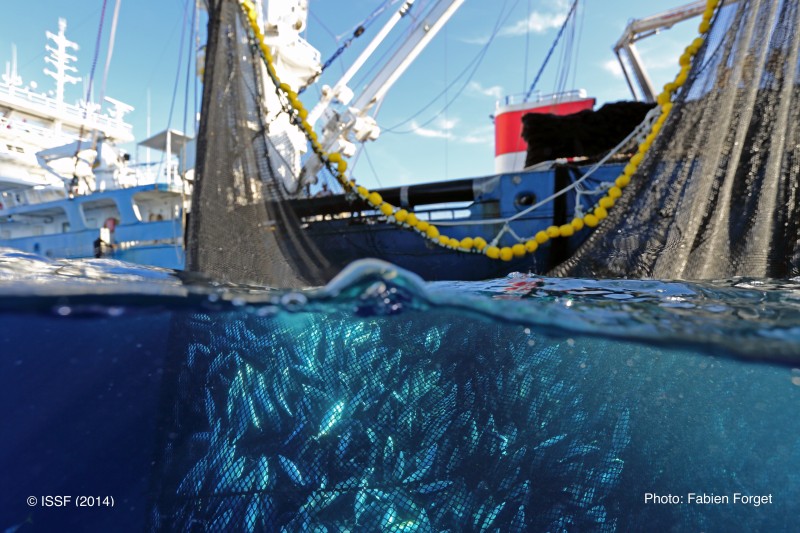November 27, 2023


Author——————————-
David Gershman
Officer, International Fisheries
✉️
The western and central Pacific is the world’s largest source of canned tuna. Skipjack tuna and albacore tuna are the two species predominantly caught for the canned tuna market and which are valued at $10 billion.
When the Western and Central Pacific Fisheries Commission (WCPFC) meets Dec. 4-8 in Rarotonga, Cook Islands, the region’s fisheries managers will have a chance to ensure the long-term sustainability of these two vital species by making further progress in developing management procedures.
A management procedure (MP) is a pre-agreed strategy for making fisheries management decisions such as setting limits on catch or fishing effort. Also known as a harvest strategy, a management procedure helps ensure sustainability by allowing managers to select the harvest control rule that is predicted through computer simulation to perform the best at maintaining the stock and fishery at desirable levels.
Albacore tuna, managed as separate stocks north and south of the equator, features prominently on the agenda of the WCPFC. Last year, WCPFC adopted nearly all elements of an MP for the north Pacific albacore stock. This year, it has a chance to fill in a critical missing piece – the information needed to operationalize a formulaic harvest control rule.
Having already been adopted in the eastern Pacific by the Inter-American Tropical Tuna Commission, adoption by WCPFC would create the first multi-regional fisheries management organization MP in the world.
One reason to develop an MP is it avoids protracted and ad-hoc negotiations on how to adjust catch or effort levels because those rules are agreed in advance. But to do that effectively, the MP should be binding on members, and its output should be directly linked to the on-the-water controls that govern vessel behavior.
At WCPFC, there’s more work to do on that front for both north Pacific albacore and skipjack. For instance, the north Pacific albacore MP is being proposed as a ‘harvest strategy’ agreement, which some members see as a decision that can be binding on the Commission. To remove any doubt or question as to its legal status, WCPFC should adopt the MP as a conservation and management measure (CMM). That would ensure members are bound to all the elements of the management procedure.
The skipjack tuna management procedure, on the other hand, was adopted last year as a CMM, but members agreed to apply it on a trial basis for six years, regrettably meaning they reserved the right to ignore its output during this time.
Now that the management procedure has been run for the first time, it should set catch or effort levels for 2024 through 2026. The result calls to set maximum fishing conditions at various baseline levels, depending on the gear, so members should have greater comfort with this approach. What this means is the WCPFC doesn’t have to make any changes to fishing on the water, since recent fishing has been less than the amount permitted by the MP. That’s good news, but not the end of the story.
Skipjack is managed through the WCPFC’s tropical tuna measure, which also regulates opportunities for bigeye and yellowfin tunas. This complex measure reflects a careful balance of members’ national interests. It has various components – some fleets have limits in the international waters, some do not. Limits in some zones are fully utilized; others are mainly aspirational. Aligning the measure to make its scheme of limits more seamlessly automate the output of the MP will take time but is a necessary task.
But, as members renegotiate the tropical tuna measure, political considerations can come into play and risk overriding the scientific advice coming from the MP. In updating the measure, members’ first objective should be to ensure a clear link to the skipjack MP and that the total catch or effort of skipjack anticipated to take place in the next three years across the Western and Central Pacific Ocean is not greater than what is recommended by the management procedure.
South of the equator, the south Pacific albacore tuna stock, though currently at healthy levels, has been subject to discussions on improving the economic viability of the fishery and preventing a significant decrease in biomass. The fishery is an important food source and economic resource to several South Pacific nations and the territories of American Samoa, New Caledonia and French Polynesia. Vessels from China and Taiwan also fish for this stock in significant numbers.
This year, a group of south Pacific island countries and Australia are proposing a revised target reference point (TRP) for the south Pacific albacore stock, which is necessary to set an overall objective for the fishery’s performance and set the stage for the eventual development of the full MP. It’s important for WCPFC to adopt a revised TRP to stay on track in developing the MP to ensure economic and biological sustainability into the future. The existing TRP, which is not currently used in management, is set at achieving a specific percentage of biomass depletion, but it is susceptible to change when new information alters the historic perception of the trajectory of the stock. The proposal on the table aligns the TRP with the level of biomass depletion experienced during a recent period (i.e., 2017-19) and thereby future proofs the TRP.
WCPFC faces important decisions on the road to modernizing its fisheries and bringing greater predictability and stability to the world’s most important source of canned tuna. Fortunately, members have shown in the past that they can work together to achieve consensus on challenging issues. If that trend continues, WCPFC will take an important step toward safeguarding some of its most important fisheries.